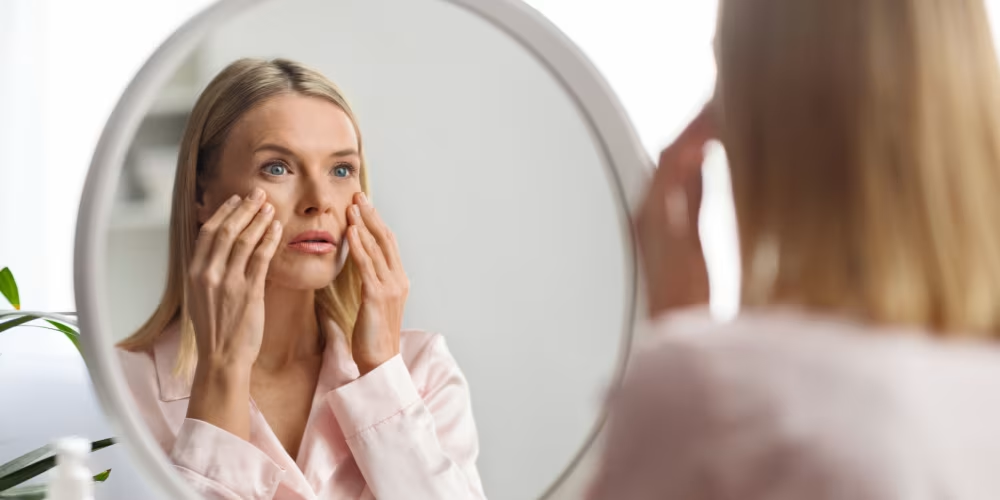Dermal filler injections have become a popular non-surgical method for enhancing facial aesthetics, smoothing wrinkles, and restoring volume. However, there are instances when these fillers may need to be removed.
In these, a board-certified plastic surgeon may use hyaluronidase enzymes to dissolve filler previously injected. Below, we’ll cover the types of fillers that are used, when fillers might need to be dissolved, and how the hyaluronidase enzyme aids in the dissolving process.

Understanding Dermal Fillers
Dermal filler injections use substances to restore volume to the skin, minimize wrinkles, and refine facial aesthetics. They are a common choice for those seeking non-surgical aesthetic treatments.
Types of Fillers Used
There are several types of dermal filler treatments that a plastic surgeon may use, each with its unique properties.
Hyaluronic Acid Fillers
Hyaluronic acid fillers are the most commonly used type of dermal filler. Our bodies make hyaluronic acid, which helps the skin stay hydrated and smooth. Hyaluronic acid filler is often used to smooth wrinkles, plump the lips, and enhance facial contours. It is also an option for those seeking a non-surgical rhinoplasty procedure to improve nasal appearance by adding volume to nasal tissues.
Calcium Hydroxylapatite Fillers
Calcium hydroxylapatite is a mineral-like compound found naturally in human bones. A dermal filler injection is used in a smooth, gel form. Fillers, like Radiesse, are typically used to fill in deeper lines and wrinkles and to enhance the cheeks and other facial contours.
Poly-L-lactic Acid Fillers
Polylactic acid is a biodegradable synthetic substance. It is used in a type of filler known as a collagen stimulator, which works differently than the other fillers. Instead of providing immediate volume, it stimulates the body to produce its own collagen over time.
When Fillers May Need to Be Removed
While dermal fillers can provide excellent results, there are times when they may need to be removed or adjusted.
Determining If Dissolution Is Needed
There are several reasons why a patient may wish to have their dermal filler dissolved. These can include changes in volume over time, the development of lumps and bumps, or allergic reactions.
Changes in Volume Over Time
Over time, the body naturally metabolizes dermal fillers, which can lead to a decrease in volume. However, if the filler is not metabolizing evenly or if too much filler was initially injected, it may result in an undesirable aesthetic outcome.
Development of Lumps and Bumps
In some cases, lumps or bumps may develop at the injection site. This can occur if the filler is injected superficially or migrates from the original site.
Allergic Reactions
While rare, allergic reactions to dermal fillers can occur. If a patient has an allergic reaction, the filler may need to be dissolved to alleviate the symptoms.

The Hyaluronidase Enzyme
When it comes to dissolving dermal fillers, the hyaluronidase enzyme plays a crucial role. This injectable enzyme is used by plastic surgeons to reverse the effects of a filler injection when necessary.
What It Is and How It Works
Our bodies naturally produce the enzyme hyaluronidase. It can break down hyaluronic acid, which is the primary component of many dermal fillers.
Naturally Occurring Enzyme
Hyaluronidase occurs naturally in our bodies, regulating the amount of natural hyaluronic acid in our tissues. When used in a clinical setting, it can help to manage the effects of hyaluronic acid dermal fillers.
Breaks Down Hyaluronic Acid
The primary function of hyaluronidase treatments in the context of filler removal is to break down hyaluronic acid dermal filler. When injected into an area where a filler has been applied, it dissolves the filler, allowing the body to naturally eliminate the broken-down particles.
The Dissolution Process
The process of dissolving dermal fillers using hyaluronidase involves a few key steps, from initial preparation to the actual injection and subsequent recovery.
Preparing for the Injection
Before the hyaluronidase treatment is administered, there are a few preparatory steps that need to be taken.
Topical Anesthesia
To minimize discomfort during the procedure, a topical anesthetic may be applied to the treatment area. This numbs the skin and makes the injection process more comfortable for the patient.
Receiving the Hyaluronidase Injection
Once the preparatory steps are complete, the patient is ready to receive the hyaluronidase injection to remove the filler and regain its natural shape.
Where It Is Administered
Hyaluronidase injections are administered directly into the area where the filler was initially injected. This ensures that the enzyme can effectively reach and dissolve the filler.
What to Expect After
Following the injection, the patient may notice an immediate effect in the volume of the treated area as the dermal filler begins to dissolve. It usually takes two weeks to see the best results after the non-surgical removal procedure, and it might be necessary to repeat it to achieve the desired outcome. Residual swelling or redness at the injection site is normal and should subside within a few days. Patients are typically able to return to their normal activities immediately following the procedure.
Conclusion
Hyaluronidase injections offer a safe and effective option for dissolving dermal fillers. Whether you’re experiencing complications from a previous filler injection or simply wish to alter the results, hyaluronidase enzymes can help. As with any procedure, it’s important to consult with a board-certified surgeon to discuss your options and ensure you receive the best possible care.
Who is Dr. Vitenas?
Dr. Paul Vitenas is an acclaimed and board-certified plastic surgeon based in Houston, Texas. As one of the most sought-after plastic surgeons in Texas and across the country, Dr. Vitenas brings decades of experience and an eye for beautiful, balanced aesthetic outcomes to each procedure.
- Board-certified plastic surgeon and founder of Vitenas Cosmetic Surgery in Houston, TX
- 30+ years of experience as a sought-after cosmetic surgeon
- Graduated from Tulane University Medical School
- Completed multiple residencies, fellowships, and instructorships
- Developed many innovative surgical techniques
- Featured in medical journals and beauty publications
With his extensive experience, awards, and dedication to patient care, Dr. Vitenas produces the exceptional, natural-looking dermal filler results that his patients look forward to.
